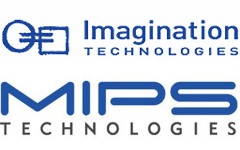Imagination Technologies Acquires MIPS Technologies
by Ganesh T S on November 6, 2012 12:02 PM EST- Posted in
- Imagination Technologies
- Arm
- MIPS

Imagination Technologies (ImgTec) announced their intent to acquire Sunnyvale-based MIPS Technologies for $60 million in cash. This price includes the operating business as well as ownership of 82 patents relevant to the MIPS architecture. The 482 remaining patents in the MIPS portfolio have been sold for $350 million to Bridge Crossing LLC, but Imagination Tech retains a royalty-free, perpetual license to them. The acquisition is expected to close in Q1 2013.
The deal brings together 2 of the top 5 semiconductor design IP vendors and strengthens ImgTec's position and opportunities in the TV/set-top-box and networking markets. While ImgTec does have its own embedded Meta 32-bit CPU core, the MIPS cores complement this lineup with the popular 32-bit and 64-bit CPU applications processors.
While the ImgTec acquisition is straightforward, the acquisition of patents by Bridge Crossing LLC seems to be worthy of further analysis. While ImgTec and MIPS don't go into the details of the companies behind Bridge Crossing LLC, ARM has come out with a press release indicating that they are a leading member of the consortium. Out of the $350 million being shelled out, ARM is contributing $167.5 million. Bridge Crossing LLC expects to license out the patents to companies who aren't part of the consortium. The acquisition of the patents by a licensing authority is more of a defensive move to prevent valuable MIPS patents from being picked up by patent trolls. While we don't have the full list of companies behind the LLC, it appears that most of them are affiliated to the Allied Security Trust, whose members include Hewlett-Packard, IBM and Intel.
MIPS has also been making a little bit of headway into the mobile space (mainly in the Chinese market), but this deal cuts down the number of players in the mobile space from three (ARM, Intel and MIPS) to just ARM and Intel now. We usually don't comment too much on the financial aspects of such acquisitions, but it does appear as if ImgTec got itself a good deal in the process.










35 Comments
View All Comments
Penti - Sunday, November 11, 2012 - link
Not really, they bought the company that collaborated with Samsung on designing the A4 (Hummingbird) in Texas. We only got to see what the PA Semi guys where up to ones they started to lead work with the Intrinsity team. Much of the skills from PA Semi had already left ship by then, other had joined. They on the other hand had plenty of experience in building SoC's and adapting processor IP – Intrinsity that is. The A6 is clearly a collaboration and merging of the two semi design teams. It would be pretty hard to do without the Intrinsity team. They would just use rebadged Samsung chips if they didn't buy Intrinisty too. They would basically have had to partner up with Intrinsity and Samsung to bring any product from the PA Semi team to market.MIPS has a much more robust tool and software support than Meta of course. Just as they went ARM because of strong support for the platform/ISA in tools and software. They would be able to build new MIPS designs with the old Meta team though for no money going to licensing it. Just receiving royalties and selling the IP. I.e. cheaper than trying to sell PPC or MIPS, or ARM physical/synthesizable processor IP without joining up with MTI. Essentially they get to design and sell MIPS cores without paying anything now, use all the patents MTI sold for free. They will probably try to sell SoC IP with their Imagination tech built in like their GPU's. Trying to get/design a more attractive platform to sell. Many ARM licensees goes with other GPU IP vendors. Becoming an ARM licensee would cost them quite some money, especially if they really like to design their own cores. As they probably want to target other markets than mobile devices ISA doesn't really matter that much, just that software is actually able to run at it. Which MTI offers.
aryonoco - Tuesday, November 6, 2012 - link
Any commentary on what ImgTech plans to do with MIPS? Do they plan to continue developing it? Are they going to just focus on the markets in which MIPS is strong, and basically is this a move to guarantee that MIPS doesn't enter the mobile Application Processor SoC market?MIPS was the pioneer of RISC, and a major part of SGI and DEC workstations. It would be sad if it completely disappears.
zzing123 - Tuesday, November 6, 2012 - link
I still remember MIPS from SGI too - I find it ironic that ARM is having problems going into the server space when MIPS used to be the king of the molehill in this department.zzing123 - Tuesday, November 6, 2012 - link
In fact I think this could prove to be a killer for ARM's server initiative. MIPS isn't exactly a stranger to supercomputing, and PowerVR can do OpenCL too (http://www.imgtec.com/forum/forum_posts.asp?TID=19... though only 1.0.So, it'd be interesting to see if we get a server SoC that has several MIPS cores leashed to several PowerVR GPUs to have a very interesting, very scaleable and very low power APU.
cocoviper - Thursday, November 8, 2012 - link
Your job sucks.